
The earthquakes that struck Nepal in April and May 2015 affected about 5.4 million people, caused the destruction of 500,000 houses and the damage of 280.000 buildings.
High numbers of masons and carpenters are needed to rebuild the houses in an earthquake resilient manner. Even before the earthquakes, Nepal suffered from a labour shortage in the construction sector due to the high labour migration to the Gulf countries and Malaysia. Therefore, the labour force has to be strengthened with additional skills trainings that include earthquake resilient building techniques and application of the revised building codes.
|
The Employment Fund has trained around 100,000 youth since 2008 in short-term trainings. Of these trainees, 50% were women and 84% come from disadvantaged groups (DAG). Of all the graduates, 74% were gainfully employed (90% overall employment). Close to 1,000 people obtained trainers certifications in construction related trades. The Employment Fund applies an outcome-based financing approach in the payment of the contracted training providers. Employment Fund is implemented by HELVETAS Swiss Intercooperation and funded by the Swiss Agency for Development and Cooperation (SDC), DFID and the World Bank. |
The Employment Fund is providing training for occupations relevant to reconstruction in six disaster-affected districts of Nepal. It has the aim of training 3,000 people in reconstruction relevant trades and focuses on the use of earthquake resilient techniques to rebuild 4,000 houses until the end of 2016.
The project does not promote standardized model houses because house types vary depending on the geographical location and their climate, traditional methods and available resources. Instead, the project applies an owner-driven approach to reconstruction by integrating earthquake resilient elements into existing construction techniques. For this purpose, Employment Fund adjusted curricula and training manuals of construction related trades in collaboration with experts in this field.
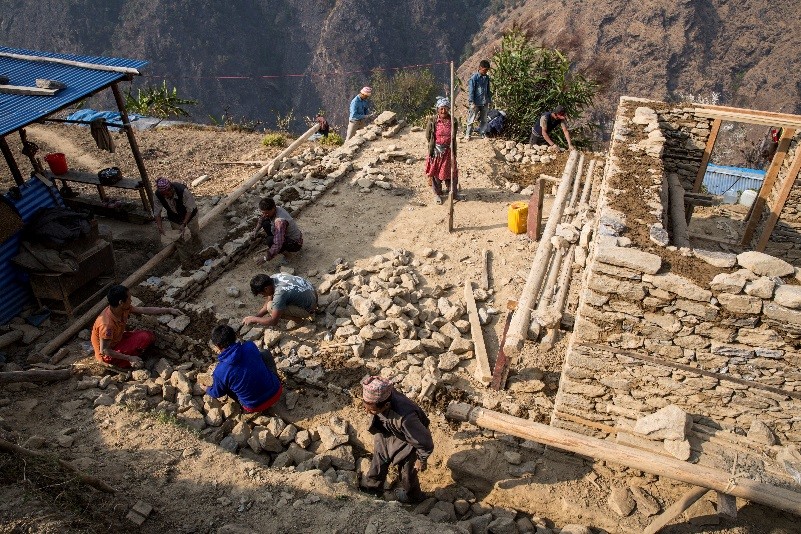 A practical session: The trainees are rebuilding a house during the training
A practical session: The trainees are rebuilding a house during the training The training takes 50 days during which 80% of the time is dedicated to practical training by rebuilding a house in the community, and 20% of the time is devoted to theory classes. After the initial training period, the participants will support other house owners in reconstruction against payment, or rebuild their own houses. Either way they are supervised by the lead instructors and supported by an engineering firm for 45 days post training. Interested trainees can register for the skills test offered by the National Skills Testing Board.
After the monsoon, the first Skills for Reconstruction trainings started in October 2015. By now, the first houses have been reconstructed and the people who have suffered the losses of the earthquake are regaining a sense of rehabilitation, healing and safety (see below).
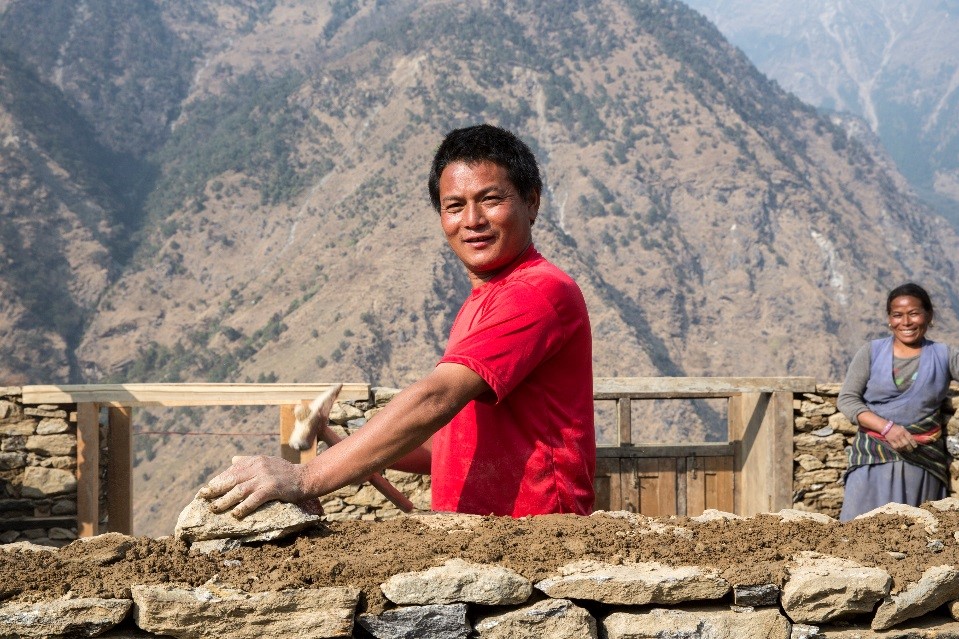 Mitra Tamang is one of the first graduates of a brick layer training in earthquake resilient technologies
Mitra Tamang is one of the first graduates of a brick layer training in earthquake resilient technologies We meet Mitra Tamang in February 2016 at a construction site not far from his house in Marbu, a widespread Sherpa and Tamang village in Dolakha district, 1'900 m above sea level. The house under construction is a private house, and Mitra is employed on a daily wage basis as a semi-skilled mason. Mitra has just graduated from a skills training in earthquake resilient reconstruction offered by the Employment Fund a few weeks ago. And there he is, with a job on a new construction ground, applying his newly acquired skills.
35-year-old Mitra was part of the very first group of trainees who reconstructed two houses in Dolakha under the instruction of a trainer trained by Helvetas. To practice and apply their new skills, the trainees rebuild a real house during the training. The first "training house" they built was a widow's house: Daulima Sherpa, a mother of four sons, who had lost her husband only months before the earthquake, and who was also a trainee in the same first group. As Mitra tells us, they advanced quickly with Daulima's two-room house, and when they finished, he was eager to make his house the second training house. He had already cleared the construction ground – quite a challenge to remove all the rubble of a collapsed traditional three-storey house – and had organized the necessary construction material before everyone else.
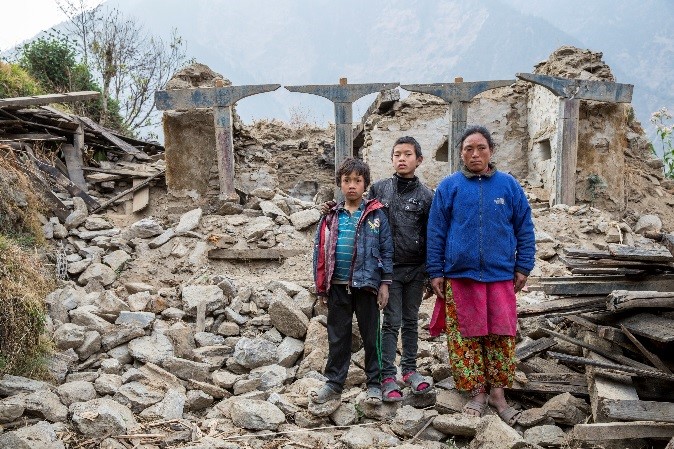
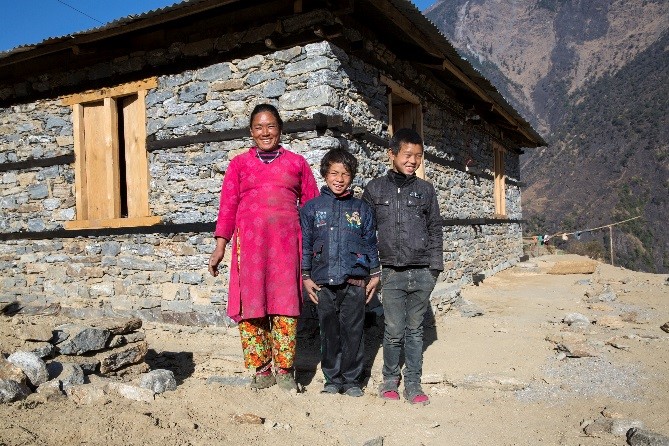 Daulima Sherpa's house was completely destroyed in the earthquake (left). The trainees rebuilt it as part of their practical training.
Daulima Sherpa's house was completely destroyed in the earthquake (left). The trainees rebuilt it as part of their practical training.
His old house was completely destroyed in the second earthquake of 12th May, like almost all other houses in Marbu. Only due to the fact that most of the families had already partly moved to shelters after the first earthquake on 25th April, which had not been as strong here, nobody in the village died or was hurt. But all the villagers became homeless. Mitra, his wife, his father's sister and his two children Samir, 3, and Susma, 10, relocated to the former hen house as a shelter after the earthquake, which is still their space for cooking and living. They now sleep in a tent that was provided by an NGO.
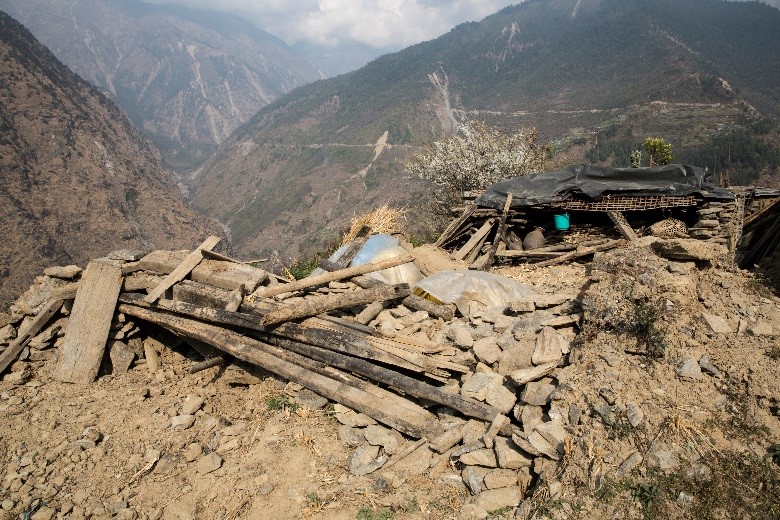 The ruins of Mitra Tamang's house. In the background: a temporary shelter for storage and cooking.
The ruins of Mitra Tamang's house. In the background: a temporary shelter for storage and cooking. Mitra proudly shows us around his new house, explains the different earthquake resilient elements, like the horizontal wooden bands in the walls, the solid cornerstones and through stones, the corner rods, the solid double frames of windows and doors and the parting walls. He explains how stones have to be dressed to make them more angular so they make a more solid wall. And he tells us that now only very little mortar is used because mud mortar has the effect of a lubricant in an earthquake, whereas dry stone construction is more solid. Only the roof of his new home is missing. It will be a light construction made of wood and corrugated iron sheets, unlike the heavy traditional stone roofs they used to build before. The few trained carpenters in the village are very busy as there is a high
 Mitra Tamang's new house is almost finished!
Mitra Tamang's new house is almost finished!
demand for their work, therefore he has to wait a little longer until he and his family can finally move into their new house.
Mitra, who attended school for only 5 years, joined the training programme after several people in the village had encouraged him to do so. He is considered very active as well as talented in construction works in the village – experience he gained because he had worked as an unskilled labourer before. These encouragements flattered him a lot and he happily applied. Before the earthquake, he had once gone to work abroad for some years but then returned to his village and entered into chicken farming and vegetable cultivation. "But now I am very happy about this new opportunity to work as a craftsman in construction work", he says. "This is how I want to make a living from now on." However, as for now, his daily wages are usually not higher than for unskilled labour; he receives around 400 Nepalese Rupees per day. "But with my skills I am getting construction jobs much more regularly", he says. "And we, all the graduated trainees, plan to call a community meeting to negotiate better and fixed rates for our work. We are now no longer labourers but skilled craftsmen after all!"
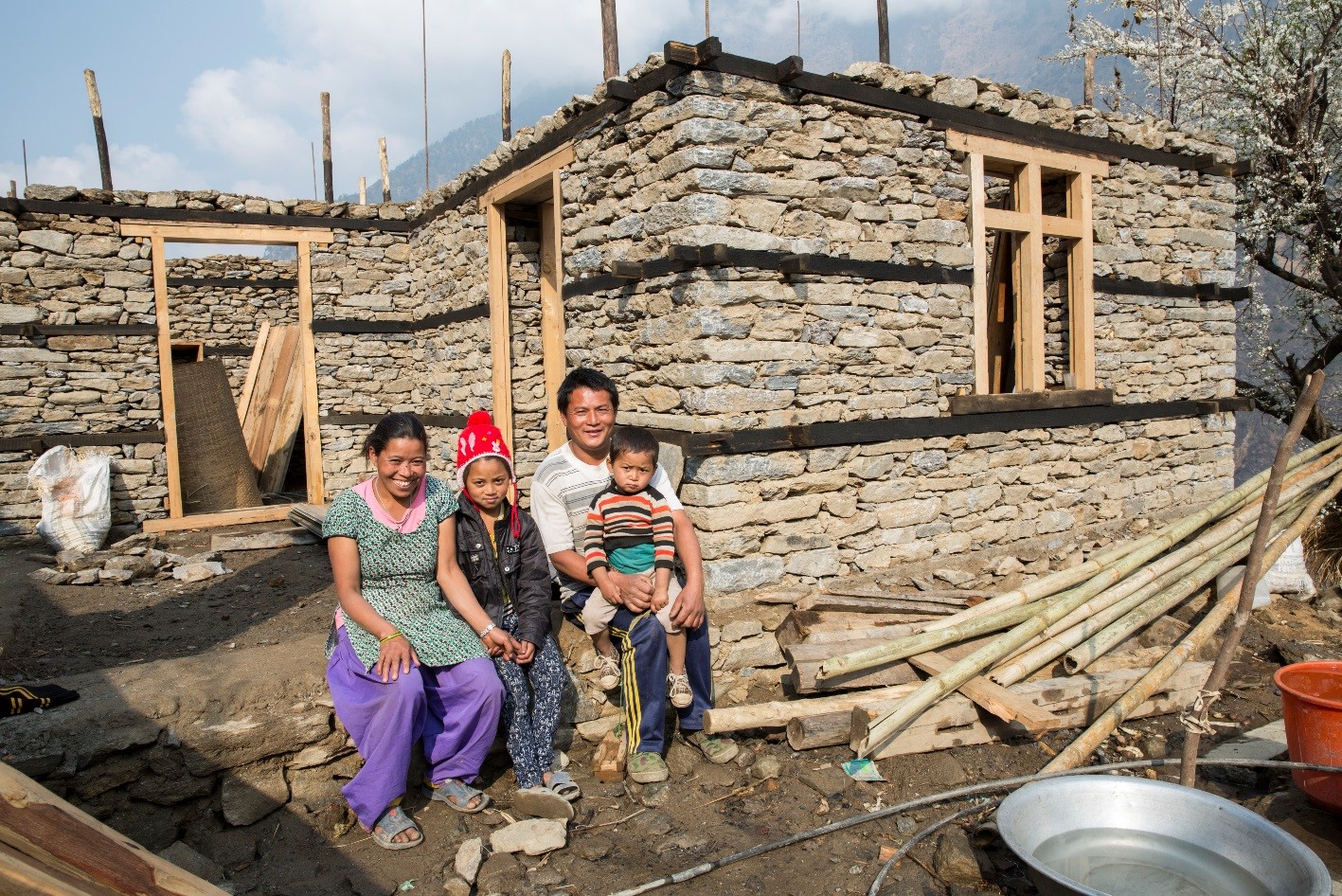 Mitra Tamang with his family
Mitra Tamang with his family
Text: Susanne Strässle and Sonja Hofstetter, Helvetas
Photos: Patrick Rohr
 download spotlight
download spotlight
